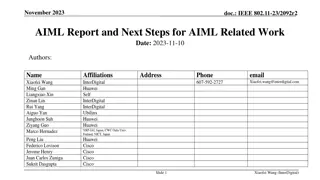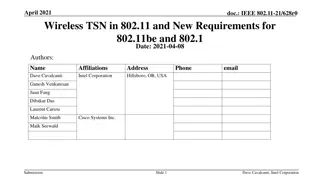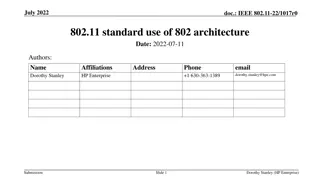Enhanced AP Coordination in IEEE 802.11 Networks
The document discusses the implementation of Restricted Transmit Wait Time (R-TWT) scheduling in IEEE 802.11 networks. It covers topics such as AP coordination, announcement of R-TWT schedules by APs, usage of 1-hop and 2-hop neighbor information for scheduling, and STA's notification of neighbor APs' R-TWT schedules. The aim is to enhance medium efficiency and avoid interference between overlapping R-TWT schedules in wireless networks.
Uploaded on Sep 10, 2024 | 1 Views
Download Presentation

Please find below an Image/Link to download the presentation.
The content on the website is provided AS IS for your information and personal use only. It may not be sold, licensed, or shared on other websites without obtaining consent from the author.If you encounter any issues during the download, it is possible that the publisher has removed the file from their server.
You are allowed to download the files provided on this website for personal or commercial use, subject to the condition that they are used lawfully. All files are the property of their respective owners.
The content on the website is provided AS IS for your information and personal use only. It may not be sold, licensed, or shared on other websites without obtaining consent from the author.
E N D
Presentation Transcript
02/10/202 Doc.: IEEE 802.11-23/0250r0 AP Coordination Date: 2023-02-10 Authors: Affiliations Address Phone email Name Liwen Chu Kiseon Ryu Huizhao Wang Hongyuan Zhang Rui Cao Yan Zhang Sudhir Srinivasa Hui-Ling Lou NXP Submission Slide 1 Liwen Chu et al (NXP)
01/10/202 Doc.: IEEE 802.11-23/0250r0 Recap: R-TWT 802.11be supports the following: An AP announces R-TWT schedule. An associated STA with the AP supporting R-TWT needs to make sure that its TXOP ends at the beginning of the AP s R-TWT active SP. This is also true for the APs in the same multiple BSSID set and co-hosted AP set. Within the R-TWT SPs, the frames of the R-TWT TIDs are serviced first. Submission Slide 2 Liwen Chu et al (NXP)
01/10/202 Doc.: IEEE 802.11-23/0250r0 Announcement of AP s R-TWT SPs and 1-hop AP s R-TWT SPs Each AP announces its R-TWT schedule (R-TWT SPs) in its Beacon frame or other management frame. The usage of other management frame can avoid the Beacon bloating. Each AP announces the R-TWT schedule of its neighbor APs. The R-TWT schedule information and the owner of the R-TWT, SSID. The neighbor s R-TWT information can also be acquired through the central management entity. Central management entity AP3 AP2 AP1 AP1 can hear the Beacon of AP2 and AP3. AP2 can t hear AP3 s Beacon. AP3 can t hear AP2 s Beacon. AP1 announces its R-TWT SPs, and R-TWT SPs of its neighbor AP2 and AP3. Submission Slide 3 Liwen Chu et al (NXP)
01/10/202 Doc.: IEEE 802.11-23/0250r0 Usage of 2-hop AP s R-TWT SPs With the information of 1-hop neighbor AP s R-TWT SPs from the neighbor AP, an AP can acquire 2-hop neighbor P s schedule information. The additional information can increase the medium efficiency, e.g. when the R-TWT APs of an AP and its 2-hop AP overlap with each other. In order to avoid interference between the overlapped TWT SPs (e.g. overlapped R-TWT SPS of AP2 and AP3 in the figure), AP2 and AP3 may restrict the maximal Tx Power of some associated STAs through spatial reuse operation. AP2 AP2 s R-TWT SP AP1 AP1 s R-TWT SP AP3 Central management entity AP3 s R-TWT SP APs R-TWT SPs without 2-hop AP s information AP3 AP2 AP1 AP2 Medium time that AP2 s BSS can use AP2 s R-TWT SP AP1 overlap with AP3 s R-TWT SPs. AP1 can hear the Beacon of AP2 and AP3. AP2 can t hear AP3 s Beacon. AP3 can t hear AP2 s Beacon. AP1 announces its R-TWT SPs, and R-TWT SPs of its neighbor AP2 and AP3. AP2 selects its R-TWT SPs that do not overlap with AP1 s R-TWT SPs, and should AP1 s R-TWT SP AP3 AP3 s R-TWT SP APs R-TWT SPs with 2-hop AP s information Submission Slide 4 Liwen Chu et al (NXP)
01/10/202 Doc.: IEEE 802.11-23/0250r0 STA s Notification of Neighbor AP s R-TWT SPs and R-TWT Selection Restriction A STA reports the R-TWT SPs of its neighbor APs to its associated AP and reports the R-TWT SPs of neighbor AP s neighbor AP. The STA s report can happen when the neighbor s updated/new R-TWT SPs are overlapped with the R-TWT SPs that the STA is the member. Another method is that when a STA detects R-TWT SP overlapping with neighbor BSS, the STA initiates the new R-TWT SP negotiation with the inclusion of its neighbor BSS s R-TWT SPs. The inclusion of such information can avoid the AP to select the TWT SP information Whose APs overlap with R-TWT SP of STA s neighbor AP. AP2 AP1 STA21 AP1 can t hear the Beacon of AP2. AP2 can t hear AP1 s Beacon. STA21 associated with AP2 can hear AP1 s Beacon. Submission Slide 5 Liwen Chu et al (NXP)
01/10/202 Doc.: IEEE 802.11-23/0250r0 Coordination among APs with Different SSIDs An AP (AP1) can announce whether it respect the R-TWT SPs of its neighbor AP (AP2) when AP1 and AP2 are not in the same ESS. Or AP1 and AP2 needs to negotiate the agreement to respect the R-TWT SPs of the peer AP. When AP1 and AP2 announces such support or successfully negotiate the R-TWT SP respect, AP1(AP2) will announce the R-TWT SPs of AP2 (AP1) and indicate that the associated R-TWT STAs need to respect AP2 s (AP1 s) R-TWT SPs. The STAs associated with AP1 (AP2) will stop its TXOP at the beginning of AP2 s (AP1 s) R-TWT Ps. AP1 (AP2) will stop its TXOP at the beginning of AP2 s (AP1 s) R-TWT Ps. For APs within the same ESS, this indication/negotiation may also be used. Submission Slide 6 Liwen Chu et al (NXP)
01/10/202 Doc.: IEEE 802.11-23/0250r0 Selective consideration of the neighbor AP s R-TWT SP When an AP announces neighbor AP s R-TWT SP schedule information to associated non-AP STAs, the AP may announce additional information indicating which non-AP STA (e.g., some of associated non-AP STAs) should follow the R-TWT rule for the neighbor AP R-TWT SP (e.g., considering the overlapping quiet interval, finishing its TXOP before the R-TWT starts). This additional information can be A Broadcast TWT ID of which member non-AP STA should consider the neighbor AP s R-TWT SP, or may not consider it (depending on the definition of the information) Receiving of the inter-BSS frame from the neighbor BSS by the non-AP STA with additional conditions such as a measurement duration and a threshold of the signal quality (e.g., RSSI, RCPI, or RSNI etc.) If a non-AP STA (e.g., STA21) receives an inter-BSS frame of the neighbor BSS (e.g., a Beacon frame sent by the neighbor AP) that exceeds the indicated threshold of the signal quality during a certain duration, the non-AP STA should consider the neighbor AP s R-TWT SP. Otherwise, a non-AP STA (e.g., STA22) may ignore the neighbor AP s R-TWT SP In addition, an AP may transmit to a non-AP STA an individually addressed management/action frame including the neighbor AP s R-TWT SP schedule information of that the non-AP STA should follow the R-TWT rule and optionally the additional information as in described above. AP2 AP1 STA22 STA21 AP2 announces AP1 s R-TWT SP schedule info STA21 associated with AP2 can hear AP1 s Beacon. STA22 associated with AP2 can t hear AP1 s Beacon Submission Slide 7 Liwen Chu et al (NXP)






















